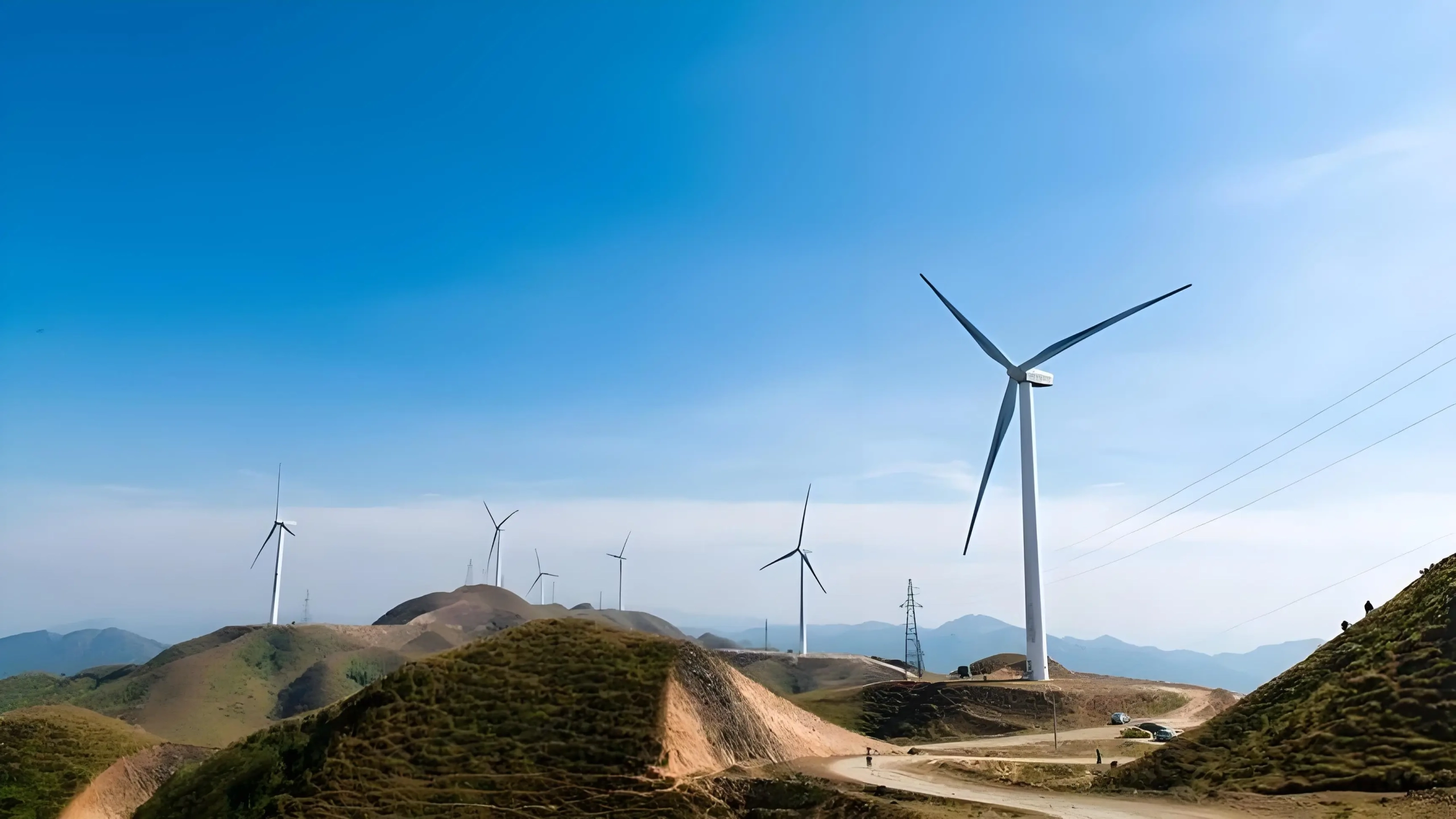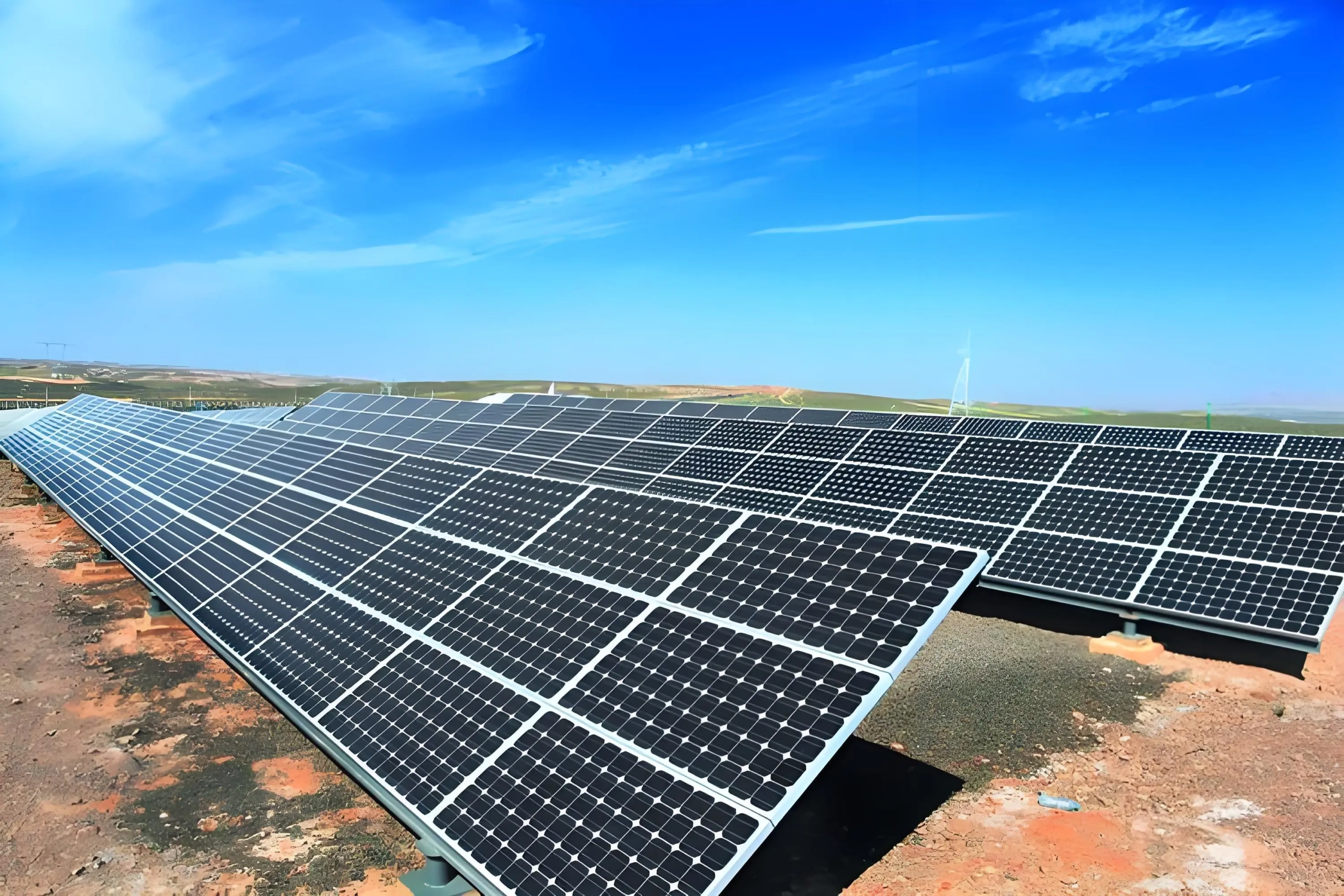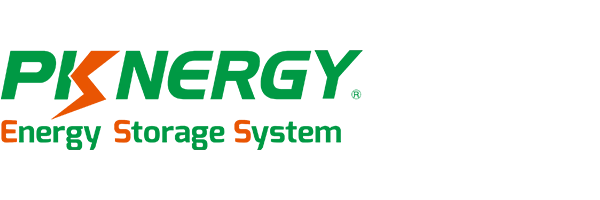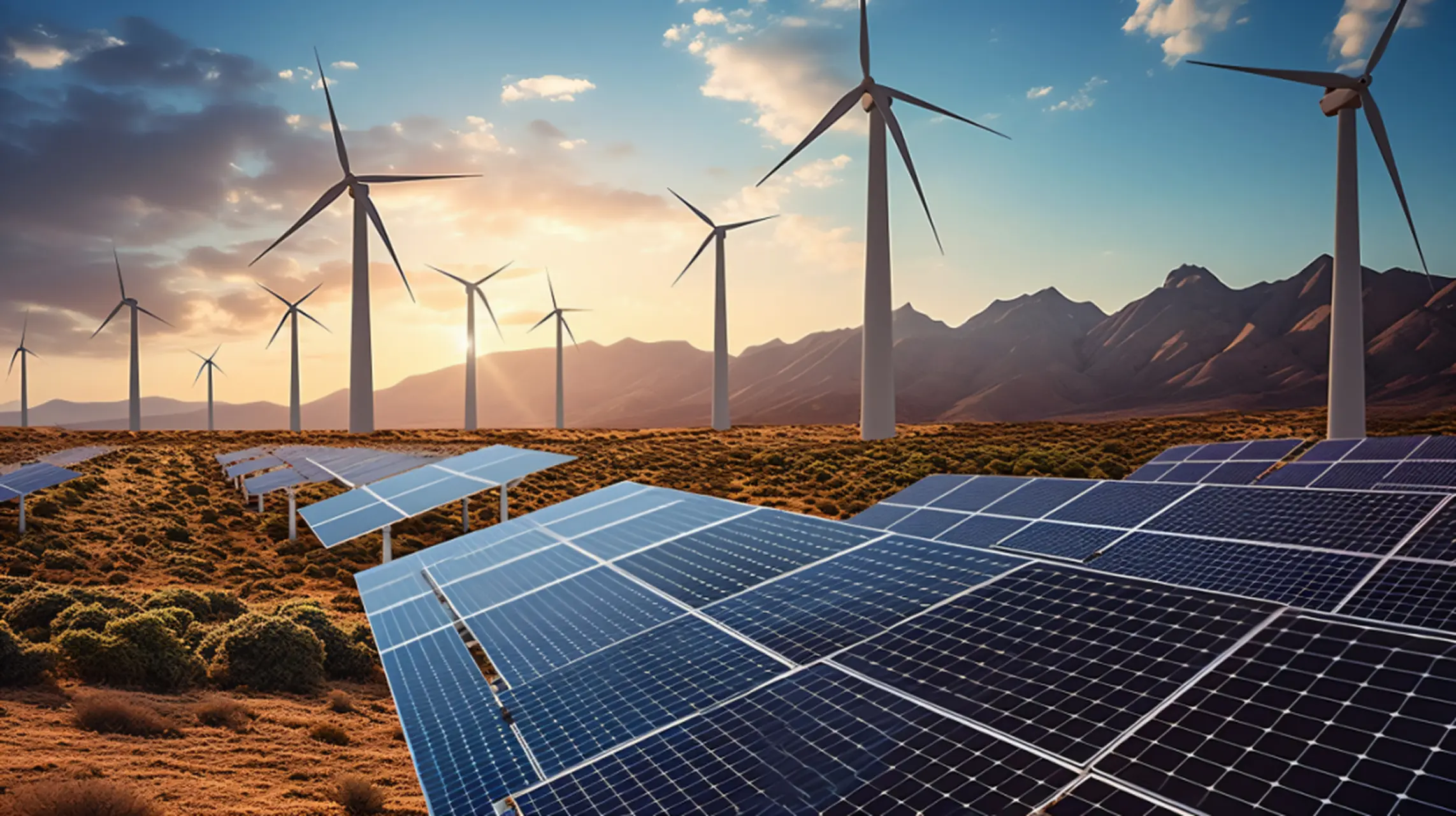Wind power and solar power are both common forms of clean energy, harnessing the power of wind and sunlight to generate electricity and reduce reliance on polluting fossil fuels. When these renewable energy sources are combined with battery energy storage systems, they can provide stable energy to remote areas and commercial facilities, lowering energy costs while contributing to global sustainable development. Below is a detailed comparison of wind power and solar power generation, helping you understand their working principles, advantages, disadvantages, and applications.
What is Wind Power Generation?
Wind power generation is the process of converting wind energy into electricity. This is done by using wind to drive the blades of a wind turbine, which then spins a generator to produce electricity. Wind power plants are typically located in areas with abundant wind resources, such as offshore or open land.
What are the Main Components of Wind Power Generation?
- Wind Turbine: This includes blades, rotor, shaft, generator, and gearbox, which are responsible for capturing wind and converting it into electrical energy.
- Tower: A steel structure that supports the wind turbine. The height is determined based on wind conditions.
- Control System: Regulates the operation of the wind turbine to ensure the generator operates at optimal wind speeds.
- Transmission System: Transports the generated electricity to the grid or storage systems.
How Does Wind Power Generation Work?
The basic principle of wind power generation is to use wind to rotate the blades of the wind turbine, which in turn drives a generator to produce electricity. The stronger the wind, the faster the turbine blades rotate, and the greater the power generation. Wind turbines automatically adjust the blade angle to optimize efficiency and extend the life of the equipment.
Advantages and Disadvantages of Wind Power Generation
Advantages:
- Clean and Pollution-Free: No carbon dioxide, pollutants, or noise pollution is generated.
- Renewable: Wind energy is continuously available—whenever there is wind, electricity can be generated.
- Low Operating Costs: Once built, the operating and maintenance costs are relatively low.
Disadvantages:
- Unstable Wind Power: Wind speeds are variable, which can affect the stability of electricity generation.
- Large Space Requirements: Wind farms need large open spaces or offshore areas, which limits the locations for their construction.
- Noise Issues: Wind turbines may generate noise, which can affect the surrounding environment.

What Are the Requirements for Building Wind Power Generation?
- Adequate Wind Resources: Wind speed and direction are critical for wind power, so wind-rich areas are needed for optimal construction.
- Land and Space: Wind farms require large, open spaces or suitable offshore areas.
- Electrical Infrastructure: A robust transmission system is needed to connect the wind power plant to the grid.
How Much Energy Can Wind Power Generate?
The energy output of wind power depends on the wind resources, the size, and design of the turbines. The generation capacity of a single wind turbine ranges from several hundred kilowatts to several megawatts. A wind farm can provide electricity to thousands or even tens of thousands of homes.
How Much Wind Power is Generated Globally Each Year?
According to the International Renewable Energy Agency (IRENA), the global annual wind power generation has surpassed 6,000 TWh (terawatt-hours), and this figure continues to grow annually, with tremendous potential for future wind power development.
What is Solar Power Generation?
Solar power generation involves converting sunlight into electricity using photovoltaic (PV) panels. It is one of the most common and widely used clean energy sources, suitable for applications of various scales—from residential rooftops to large solar power plants.
What are the Main Components of Solar Power Generation?
- Photovoltaic Modules (Solar Panels): Made up of multiple photovoltaic cells that convert sunlight into direct current (DC) electricity.
- Inverter: Converts the direct current (DC) electricity generated by the solar panels into alternating current (AC) electricity, which is suitable for use in homes or commercial grids.
- Battery Storage System (Optional): Stores excess power to ensure a stable supply even when there is no sunlight.
- Power Controller and Wiring System: Ensures the system operates efficiently and stably.
How Does Solar Power Generation Work?
Solar power generation works by using photovoltaic panels to convert sunlight into direct current (DC) electricity. When sunlight strikes the silicon cells in the panels, it excites electrons, generating electricity. This electricity is then converted into alternating current (AC) by the inverter, making it usable for homes or businesses.
Advantages and Disadvantages of Solar Power Generation
Advantages:
- Clean and Eco-Friendly: Solar power produces no pollution and relies entirely on renewable solar energy.
- No External Energy Input Required: Once installed, solar power systems do not require external energy, and maintenance is minimal.
- Highly Flexible: Can be applied in various sizes, from small household devices to large-scale power plants.
Disadvantages:
- Unstable Sunshine: Solar power generation is affected by weather, seasonal changes, and geographic location, which impacts its stability.
- Large Space Requirements: To generate efficient power, solar panels need large surface areas.
- High Initial Investment: The cost of installing a solar power system can be high, but the cost is decreasing over time due to technological advancements.

What Are the Requirements for Building Solar Power Generation?
- Adequate Sunlight: Locations must receive sufficient sunlight every day to make solar power generation effective.
- Space Requirements: Solar panels need a large area to achieve high efficiency.
- Grid Connectivity: For commercial and industrial users, connecting to the grid is essential for distributing generated power.
How Much Energy Can Solar Power Generate?
The amount of electricity generated by solar power depends on location, season, and the scale of the installation. In sunny areas, solar panels can generate 1,000 to 2,000 kilowatt-hours (kWh) per kilowatt of installed capacity annually.
How Much Solar Power is Generated Globally Each Year?
Global solar power generation has exceeded 3,000 TWh annually, and this number continues to grow as technology advances and installations increase.
Comparison of Wind Power and Solar Power
| Dimension | Wind Power | Solar Power |
| Resources | Depends on wind, ideal for areas with stable wind speeds | Depends on sunlight, ideal for areas with strong sunlight |
| Power Generation Capacity | Single wind turbine generates substantial power, suitable for large-scale generation | Suitable for various power scales, from residential to commercial applications |
| Stability | Wind power is intermittent, with variable wind speeds | Solar power is affected by weather and seasons, with lower stability |
| Installation Space | Requires large land areas or offshore regions | Requires large rooftops or open spaces |
| Environmental Impact | Can produce noise and affect birds | No noise, environmentally friendly |
| Investment Costs | High initial investment, but low operational costs | High initial investment, but low maintenance costs |
Which is Better, Wind Power or Solar Power?
There is no definitive answer, as both wind power and solar power have their advantages and disadvantages. Wind power is more suitable for regions with abundant wind resources, while solar power works best in areas with strong sunlight. They can be used together to complement each other.
Which Requires More Investment, Wind Power or Solar Power?
Generally, wind power requires a higher initial investment due to the infrastructure and equipment needed for wind turbines. In contrast, solar power tends to have a lower initial cost, especially for distributed photovoltaic systems.
Can Wind and Solar Energy Be Used Together?
Yes, wind and solar energy can be used together to create a more reliable energy system. Wind energy tends to be stronger at night or in different seasons, while solar energy performs best during the day. Combining both helps ensure a more consistent power supply, especially in areas where one source may be intermittent.
The success of combining wind and solar depends on choosing the right location. Wind and solar resources are not evenly distributed. For example, areas with strong sunlight but little wind may not benefit much from wind power, and vice versa.
Which is More Suitable for Residential Use, Wind Power or Solar Power?
For households, solar power is often the more suitable option, especially for homes located in areas with abundant sunlight. Solar panels can be installed on rooftops, and they require relatively less space compared to wind turbines. This makes solar power more cost-effective and easier to manage for residential applications.
On the other hand, wind power typically requires larger spaces and more equipment, making it better suited for larger-scale power generation sites such as wind farms. For homes, installing a wind turbine may be costly due to the need for a large installation area, specialized equipment, and infrastructure.
If you’re considering transforming your home’s power system into an off-grid system, you can contact PKNERGY for a free load estimation and energy solution. We can help you determine the right number of solar panels and battery capacity needed to build a reliable home backup power system.
Conclusion
Wind power and solar power each have their strengths and are suitable for different geographical areas and environments. By combining and optimizing their use, they provide sustainable, clean solutions for global energy needs.
FAQ
Does Wind Power Kill Birds?
Yes, wind turbines can sometimes be a risk to birds, especially in areas with significant bird populations. However, proper placement of wind farms and technology improvements can minimize this risk.
How Long Are Wind Turbine Blades?
The length of wind turbine blades varies depending on the turbine’s size, but most blades are between 40 and 60 meters long.
Does Solar Power Cause Light Pollution?
No, solar panels do not create light pollution as they do not emit light. They simply absorb sunlight and convert it into electricity.
Save Money, Protect Environment
PKNERGY helps you reduce your energy bills for your home solar energy storage, store your solar energy for use anytime- at night or during an outage.





